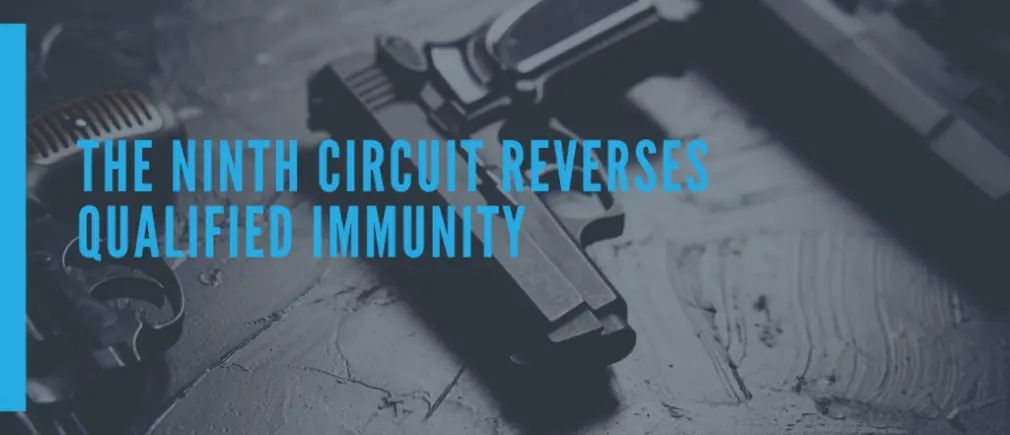Ninth Circuit Reverses Qualified Immunity on Firearm Possession and Deadly Force

On the afternoon of October 31, 2019, in San Jose, Decedent Calonge was spotted near a shopping center carrying a Powerline 340 BB gun. Mistaking it for a real handgun, a passerby called 911. Shortly after, another caller reported seeing a man with a gun near Independence High School, prompting concern for the students’ safety. Several officers, including Officer Carboni, were dispatched to the area.
As Officer Carboni approached, he saw Calonge walking toward the officers with the gun in his waistband and his hand resting on it. The officers shouted multiple commands for him to show his hands and drop the gun. Calonge paused, crossed the street, and started walking away from the officers but towards the school. Despite the commands, Calonge continued walking slowly, occasionally looking back and smiling.
Officer Carboni, after briefly communicating with his fellow officers, warned them he was going to shoot. He then steadied his rifle and shot Calonge in the back, killing him. This occurred just over a minute after Carboni exited his vehicle, without any prior warning to Calonge that he would be shot.
Officer Carboni justified the shooting by claiming he saw Calonge’s arm move as if drawing the gun and feared he would take nearby students hostage. However, other officers and body-worn camera footage contradict these claims, showing no clear evidence of Calonge reaching for his gun or any bystanders near him at the time.
Ms. Calonge, representing her son, sued Officer Carboni under 42 U.S.C. § 1983, claiming he violated her son’s Fourth Amendment right against excessive force. Officer Carboni sought summary judgment, asserting qualified immunity on the grounds that his actions did not breach the Constitution or that the law wasn’t clearly established. Ms. Calonge opposed this, arguing that there were genuine disputes of material fact and that the law was clearly established, though she did not provide specific case precedents, believing the violation was obvious.
The district court ruled in favor of Officer Carboni, granting him qualified immunity. The court decided that Ms. Calonge did not provide specific case law to clearly show that Officer Carboni’s actions violated the Fourth Amendment, thereby entitling him to summary judgment.
The Fourth Amendment protects against unreasonable searches and seizures. When a police officer uses deadly force, it counts as a seizure under this amendment. For a seizure to be constitutional, it must be objectively reasonable, which involves balancing the individual’s rights against the governmental interests at stake. This is assessed from the viewpoint of a reasonable officer at the scene.
In this case, Officer Carboni’s use of deadly force against Calonge was scrutinized. Deadly force is highly intrusive due to the fundamental value of life. The key factors considered were the severity of the crime, the threat posed by the suspect, and whether the suspect was resisting or fleeing arrest. The most crucial factor is whether the suspect posed an immediate threat.
Taking the facts favorably for Ms. Calonge, it appears that Calonge did not pose an immediate threat. Although Officer Carboni mistakenly thought Calonge had a real gun, possessing a gun does not justify deadly force unless the person makes a threatening move, which Calonge did not. Additionally, there were no bystanders nearby to justify such force.
Officer Carboni’s commands to Calonge were conflicting, making compliance difficult. Even if the commands were eventually clear, Calonge’s brief non-compliance did not justify deadly force. Walking away without being told to stop does not count as fleeing arrest.
Moreover, Calonge’s conduct was only a misdemeanor under California law, which does not warrant high levels of force. Finally, Officer Carboni did not warn Calonge before shooting, even though he had time to do so, making the use of deadly force even more unreasonable. Therefore, a reasonable jury could find that Officer Carboni’s actions violated Calonge’s Fourth Amendment rights.
The Ninth Circuit then looked at whether the Fourth Amendment violation was clearly established in this case. The law is considered clearly established when previous cases make it obvious that the officer’s actions were unlawful. This standard requires that every reasonable officer would know that their conduct was wrong given the specific situation they faced.
Officer Carboni argued that Ms. Calonge didn’t properly argue this point because she didn’t cite similar cases in the lower court. However, based on the Supreme Court’s ruling in Elder v. Holloway, appeals courts must consider all relevant precedents, not just those presented in the lower court. Therefore, the Court can examine additional cases.
Using the Court’s full understanding of the law, the Court of Appeals concluded that a reasonable jury could find that Officer Carboni violated the Fourth Amendment. The precedents the Court of Appeals relied on were clear and existed well before the shooting in 2019, establishing that police cannot use deadly force on someone just for possessing a gun without an immediate threat.
Several cases support this view:
- In George, officers shot a man holding a gun pointed down without any immediate threat.
- In Cruz, officers shot a man they thought was reaching for his waistband, which was unreasonable without a clear threatening gesture.
- In Lopez, an officer shot a boy holding what looked like an AK-47 without the boy pointing it at anyone or threatening them.
Additionally, Gravelet-Blondin establishes that conflicting police commands cannot justify shooting a suspect for non-compliance until a clear command is given and ignored. In Landeros, simply continuing to walk is not considered fleeing from arrest.
Officer Carboni tried to argue that Blanford v. Sacramento County showed the law wasn’t clearly established, but Blanford involved consistent commands and clear threats from a suspect with a sword, which is different from this case where commands were conflicting, and the suspect posed no immediate threat.
Accordingly, the Ninth Circuit Court of Appeals, reversed the District Court’s award of Qualified Immunity.
Follow this link to read the opinion.
Follow his link to view the video of the oral argument.


